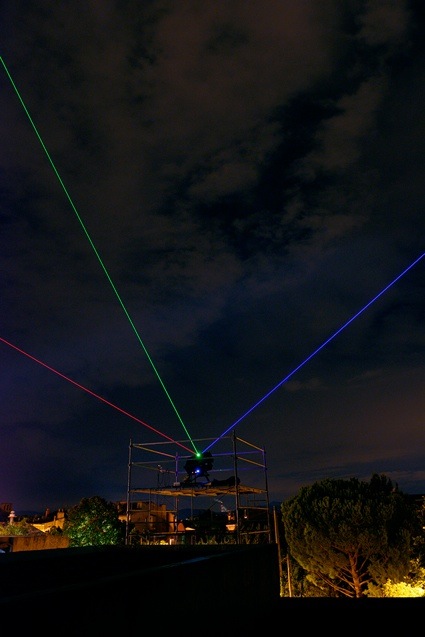 Constance, 2013. Photo by Luce Moreau
Constance, 2013. Photo by Luce Moreau
I’ve finally gone through all the images and texts i made and received from the GAMERZ festival in Aix-en-Provence. There’s a ridiculously high amount of new artists and works i’d like to blog about but let’s start with what i think were the smartest and most elegant works in the festival. Both play with perception, both are by Luce Moreau, a member of the collective Otto-prod.
The first one is Constance, an installation set on the roof of one of the buildings of the School of Fine Arts in Aix-en-Provence and visible at night from a distance of several kilometers. Constance’s 3 powerful laser axis were shining orthogonally from a box attached to a motorized equatorial frame (motorization by Patrick Reybaud). An equatorial frame is an instrument that astronomers attach to telescopes and cameras so that they can stay fixed on any object in the sky. The equatorial mount moves imperceptibly but steadily, thus canceling its own driving force by earth movement. The origin of the three axes remains with it in one point in space, as if in weightlesness.
Luce Moreau, Pulsar, 2012
The second work she was showing is Pulsar which also makes use of the equatorial mount. This time the artist filmed a perfectly immobile sun. She used an old camera which -see explanations below- is protecting itself from the powerful light of the sun by opening and closing its diaphragm.
Luce has otherwise a pretty spectacular portfolio. Have a look at Landmarks. She interrupted otherwise mundane landscapes with a system of mirrors that reflect sun rays in the direction of the camera lens.
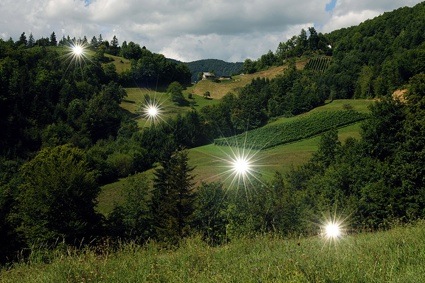 Jazbine, from the series Landmarks, 2010
Jazbine, from the series Landmarks, 2010
But back to Constance and Pulsar. I asked Luce if she could give us more details about the works. The Q&A is below and if you scroll down you can also read her answers in french. Here we go…
Hi Luce! The lasers of Constance are visible from afar. How far away exactly? Why is it important that the rays can be seen from such a distance?
This is the first version of the Constance installation, it’s a beta version for which I worked with a Slovakian workshop which specializes in renting lasers. We worked on making this special box containing three lasers oriented orthogonally to each other. We opted for the most powerful model they had (10 to 12 W), so that the lasers can reach as far as possible. Currently the laser rays can be seen from a distance of a few kilometers, but I can not measure exactly the distance at which we “lose sight” of them. The installation aims to disrupt our daily and familiar landscapes, punctuate our environment with this colorful landmark so that we start considering our relationship to time and space. It acts as a kind of clock at the scale of the landscape, it’s a mechanism that we must decipher.
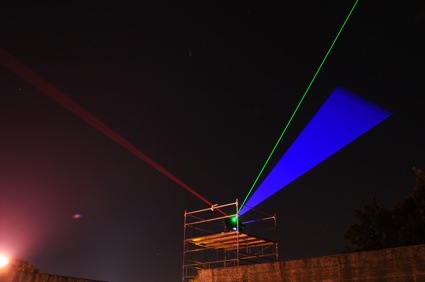 Constance, 2013. Photo by Luce Moreau
Constance, 2013. Photo by Luce Moreau
And how do people who know nothing about this art installation interpret them when they see them in the sky?
I think that it depends on the context. During GAMERZ, Constance was central, located in the heart of the festival, in the city center. In this case, the global three rays were only visible from the outside of the city, and from a certain height. Festival goers and residents of the city center might have been intrigued and even perhaps attracted by these strings of light which ‘hung’ above their heads and led to the festival. It became more interesting when the public was in close proximity of work (less than 10 m.) The curious could walk around the installation and see the rays at their maximum strength. The proximity doesn’t really allow you to understand the lasers movement, on the other hand, it offers an excellent visibility of the 3D effect.
When Constance is presented in Pau (13, 15 and 16 November at the festival Accès-s Cultures Électroniques), it will be in a completely different context. Installed on top of a hill outside the city, the work should offer the residents of Pau and its environs a more mysterious, distant vision. The imperceptible movement of lasers will be more apprehensible for visitors and locals. They see more clearly the path traveled over a few hours, but it will be less easy for them to observe the work from up close.
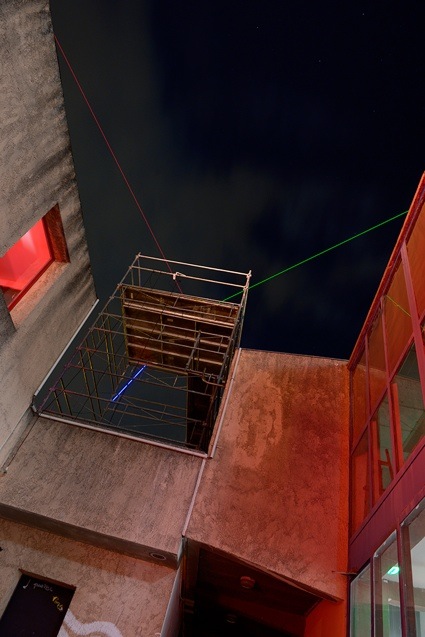 Constance, 2013. Photo by Luce Moreau
Constance, 2013. Photo by Luce Moreau
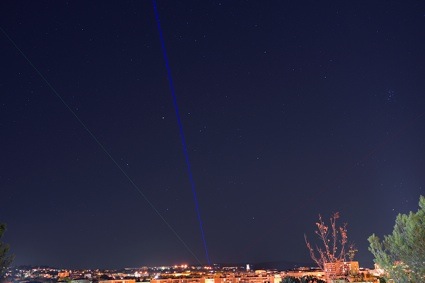 Constance, 2013. Photo by Luce Moreau
Constance, 2013. Photo by Luce Moreau
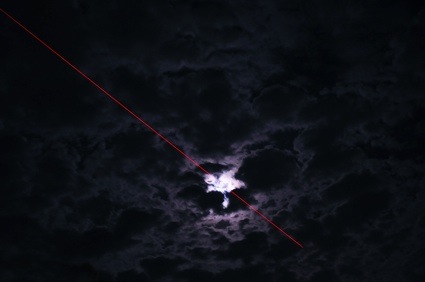 Constance, 2013. Photo by Luce Moreau
Constance, 2013. Photo by Luce Moreau
Can exhibition visitors ever perceive what is happening?
I think visitors are first impressed by the power and finesse of the rays, the colors vibrate in a very particular way, and represent many threads stretched between them and the universe. Then they understand the immobility of the green ray, and see that its extremity points to a star, Polaris. From that moment, and with the help of some explanations if needed, everything falls into place and the installation awakens what lies dormant in a corner of the brain: our understanding of the world, our planet in its system, its infinity, and all the vertigo that it implies! Two visitors gave me their diametrically opposed impressions. The first experienced a sense of vertiginous emptiness, the installation embodying the oblique axis of our position on earth. The second person talked about being reassured by having a beacon, a landmark in this enormous universe.
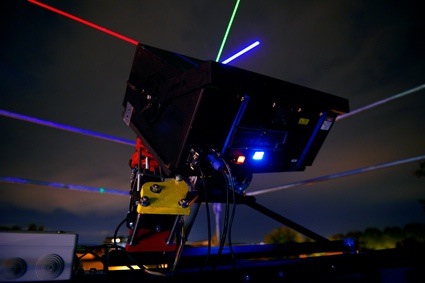 Constance, 2013. Photo by Luce Moreau
Constance, 2013. Photo by Luce Moreau
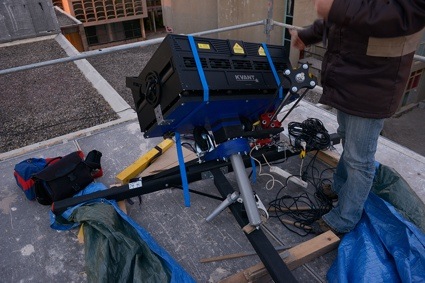 Installation of Constance for the GAMERZ festival. Photo by Luce Moreau
Installation of Constance for the GAMERZ festival. Photo by Luce Moreau
The installation uses a motorized equatorial mount. Could you explain how it works and where/how you discovered about it?
I’ve discovered this system while I was working at the Observatory of Provence (OHP-CNRS) in the Summer of 2011.
I had the idea of photographing or filming a landscape, freed from the movement of the Earth and I was curious to see how that would turn up. So I started thinking about a traveling rail system, calculating the speed of the rotation of the earth, obsessing over many practical details… Then one day while chatting with an amateur astronomer (Olivier Labrevoir), I found out about the equatorial mount, a very simple tool that sky watchers have used for decades to follow sidereal objects (stars, planets, etc. ) and that would allow me to get the effect i was looking for. The principle of this tripod is to rotate the visualization object (telescope, or photo and video cameras in my case) around a central axis, the axis being parallel to the axis of rotation of the Earth. To do this, the axis must point to the Pole Star, which happens to be very close to the geographic north of our planet and is therefore the only one that stand still when the earth rotates on its axis. This movement is motorized, the motors follow the exact same speed as the earth, but in the opposite direction. The camera is thus ‘immobile’. It floats in weightlessness! And so is our point of view…
You used the equatorial mount in several of your work. Why do you find this point of view on our surrounding so fascinating?
I find this tool fascinating as for me, it represents a shift in meaning, the power to be in a state of weightlessness without leaving the ground … a unique perspective that I had never experienced before, which is one of perfectly precise static condition. In order to explain the process, I often compare it to a jump that stays frozen in the air and that allows you to observe the planet that continues revolving. But without us. This is a levitation, a slow and gradual flying process, an experience and perspective I wanted to share.
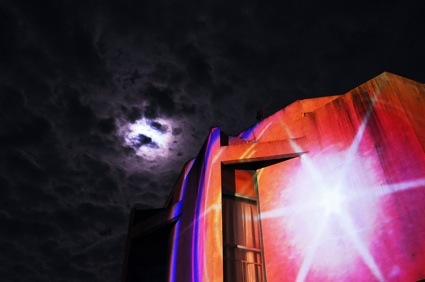 Pulsar, 2012 (view at the GAMERZ festival 2013)
Pulsar, 2012 (view at the GAMERZ festival 2013)
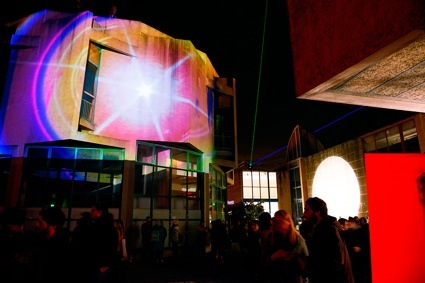 Pulsar, 2012 (view at the GAMERZ festival 2013)
Pulsar, 2012 (view at the GAMERZ festival 2013)
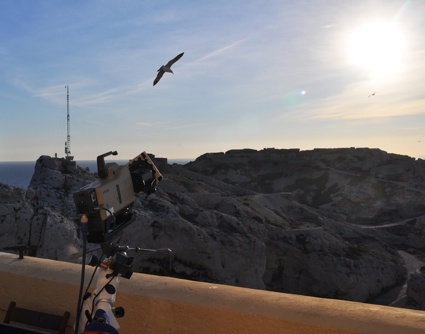 Shooting Pulsar
Shooting Pulsar
Do you have drawings or other image that would show visually the process used to make Pulsar? (mostly because i cannot understand very well how it was made)
Unfortunately I don’t :) but i can explain:
Pulsar is filmed using the same tripod but this time the sole purpose is to focus on the sun and keep it stationary in the frame. The camera is an old, obsolete and fragile camera which “prints” momentarily the bright lights onto its sensor. In an effort to draw an analogy between the human eye and the camera sensor, I wanted to take advantage of this flaw and obtain a set of persistence of vision. The intermittent closure of the diaphragm is an automatic protection of the camera, which closes its “lid” when it feels assaulted by too much light. If you were standing next to the camera, you would see the diaphragm ring oscillating from 16 (minimum aperture) to C (total closure.) The camera is protecting itself from the offensive and destructive sun.
Merci Luce!
Constance is a co-production M2FCréations, Accès-s Cultures Électroniques and Otto-Prod. Check out Luce’s work at the Soleils Numériques festival ACCES(S), from 10 to 23 November in Pau and around, France.
———————
And now for the version in french:
The lasers of Constance are visible from afar. How far away exactly? Why is it important that the rays can be seen from such a distance?
L’installation Constance en est à sa première version, une version bêta pour laquelle j’ai travaillé avec un atelier slovaque de location lasers. On a collaboré sur la fabrication de ce boîtier spécial renfermant trois lasers orientés de façon orthogonale les uns par rapport aux autres ; nous avons choisi ce qu’ils avaient de plus puissants (de 10 à 12 W), afin que les lasers se voient du plus loin possible. Actuellement nous pouvons voir les rayons lasers jusqu’à quelques kilomètres, mais je ne peux pas savoir exactement à quelle distance nous les “perdons de vue”. L’installation a pour but de perturber nos paysages familiers et quotidiens, d’annoter notre environnement de ce repère coloré afin d’être amené à considérer notre rapport au temps et à l’espace. Une sorte d’horloge à l’échelle du paysage, un mécanisme qu’il nous faut déchiffrer.
And how do people who know nothing about this art installation interpret them when they see them in the sky?
Je pense que cela dépend du contexte ; lors du Fetsival GAMERZ, Constance était centrale, installée au coeur du festival, dans le centre ville. Dans ce cas précis, les trois rayons n’étaient visibles ensemble que de l’extérieur de la ville, d’un point de vue en hauteur ; les festivaliers et habitants du centre ont pu être ntrigués, peut-être attirés par ces fils de lumière au-dessus de leurs têtes, qui menaient au festival. L’intérêt que j’y ai trouvé était la proximité du public face à l’oeuvre : les plus curieux pouvaient graviter autour de l’installation à moins de 20 mètres et voir les faisceux dans leur puissance maximum. La proximité permet moins de comprendre le mouvement iopéré par les lasers, mais offre une visibilité privilégiée de l’effet de 3D.
Lorsque que Constance sera présentée à Pau (les 13, 15 et 16 novembre au festival Accès-s Cultures Électroniques), ce sera dans un tout autre contexte ; installée sur les hauteurs d’une colline, à l’extérieur de la ville, elle devrait offrir aux habitants de Pau et de ses environs une vision plus mystérieuse, lointaine. Le mouvement imperceptible des lasers sera ainsi plus compréhensible par les visiteurs et les habitants. Ils verront mieux la trajectoire opérée en quelques heures, mais pourront moins facilement l’observer de près.
How about the exhibition visitors. Can they ever perceive what is happening?
Les visiteurs sont je pense tout d’abord impressionnés par la puissance et la finesse des rayons, dont les couleurs vibrent de façon très particulière, et qui représentent autant de fils tendu entre eux et l’univers. Puis ils comprennent l’immobilité du rayon vert, et voient que son extrémité pointe une étoile, la Polaris ; à partir de ce moment-là; et avec l’aide de quelques explications si besoin, tout se met en place et cette installation excite ce qui vit dans un coin de chaque cerveau : notre appréhension du monde, de notre planète dans son système, son infinité, et tout le vertige que ça sous-entend! Deux visiteurs m’ont ainsi donné leurs impressions contraires : la première avait un sentiment de vide vertigineux, l’installation matérialisant l’oblique de notre position sur terre, quant à la seconde elle était rassurée par le fait d’avoir une balise, un repère dans cet ensemble démesuré.
The installation uses a motorized equatorial mount. Could you explain how it works and where/how you discovered about it?
I’ve discovered this system while I was working at the Observatory of Provence (OHP-CNRS) in summer 2011. J’avais eu l’idée de photographier, ou filmer un paysage, affranchi du mouvement de la Terre ; j’étais curieuse de voir ce que ça pouvait donner. J’ai donc commencé à réfléchir à un système de rail de travelling, calculer la vitesse de rotation de la terre, me prendre la tête sur beaucoup de points pratiques… Quand au cours d’une conversation avec un astronaume amateur (Olivier Labrevoir) j’appris l’existence de la monture équatoriale, outil très simple dont les observateurs du ciel se servent depuis plusieurs dizaines d’années pour suivre des objets sidéraux (étoiles, planètes, etc) et qui me permettrait d’obtenir le résultat recherché. Le principe de ce trépied est de faire pivoter l’objet de captation (téléscope, ou appareil photo et caméra dans mon cas) autour d’un axe central, cet axe étant parallèle à l’axe de rotation de la Terre. Pour ce faire, l’axe doit pointer l’étoile polaire, qui se trouve être très proche du Nord Géographique de notre planète ; elle est donc la seule à rester immobile lorsque la terre tourne sur son axe. Ce mouvement est motorisé, les moteurs pas à pas vont à l’exacte vitesse de rotation de la terre, en sens inverse ; la caméra fait ainsi du “surplace”. Elle est en apesanteur! Et notre point de vue avec elle…
You used the equatorial mount in several of your work. Why do you find this point of view on our surrounding so fascinating?
Je trouve cet outil fascinant car il représente pour moi, par glissement de sens, le pouvoir d’être en état d’apesanteur sans quitter le sol…un point de vue inédit, que je n’avais jamais pu observer auparavant, qui est celui du statisme le plus exact ; souvent pour expliquer le procédé, je parle d’un saut surplace, mais durant lequel on reste figé dans les airs, et durant lequel on peut observer notre planète continuer à tourner, sans nous. C’est une lévitation, un procédé d’envol lent et progressif, et dont je voulais partager le témoignage et le point de vue.
Do you have drawings or other image that would show visually the process used to make Pulsar? (mostly because i cannot understand very well how it was made)
Unfortunately I don’t :) mais je peux expliquer :
Pulsar est filmée depuis ce même trépied qui est ici utilisé dans le seul but de centrer le soleil et de le garder immobile dans le cadre. La caméra est une vieille caméra, obsolète et fragile, qui “imprime” momentanément les fortes lumières sur son capteur. Dans une volonté d’analogie entre l’oeil humain et le capteur de la caméra, j’ai voulu profiter de cette lacune et obtenir un jeu de persistance “rétinienne” ; la fermeture intermittente du diaphragme est une protection automatique de la caméra, qui ferme sa “paupière” lorsqu’elle se sent agressée par trop de lumière. Si tu étais surplace aux côtés de la caméra, tu verrais osciller la bague du diaphragme de 16 (ouverture minimum) à C (fermeture totale) ; la caméra se protège de ce soleil offensif et destructeur.
Merci Luce!
Constance est une co-production M2FCréations, Accès-s Cultures Électroniques et Otto-Prod. Le travail de Luce sera au festival Soleils Numériques – ACCES(S), du 10 au 23 Novembre, Pau et agglo, France.
